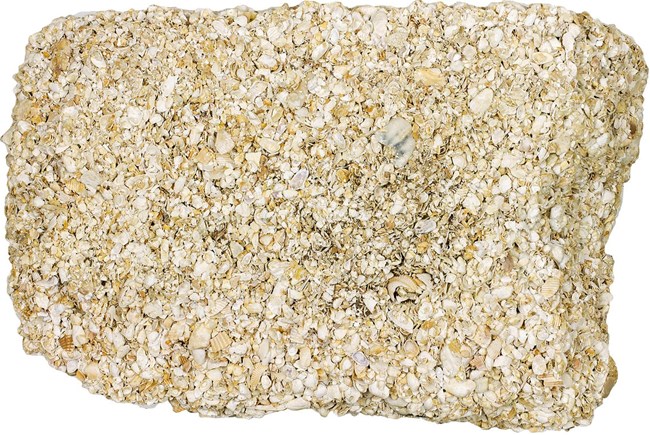
A Fort Made Out of Seashells?Who would think that a fort made of seashells would last 300 years? Who would think that a fort made out of seashells would last three days under cannon fire? But the Castillo de San Marcos, made of local coquina stone, did just that. What exactly is this strange rock? How was it formed, and where did it come from? And how did this rock shape the history of St. Augustine? How Coquina is FormedThousands of years ago, the tiny coquina clam donax variabilis lived in the shallow waters of coastal Florida, as they still do today. These are the small pink, lavender, yellow, or white shells one sees along the beach at the waterline. As the resident clam died, the shells accumulated in layers, year after year, century after century, for thousands of years, forming submerged deposits several feet thick. During the last ice age, sea levels dropped, exposing these shell layers to air and rain. Eventually, the shell became covered with soil, then trees and other vegetation. Rain water percolating through the dead vegetation and soil picked up carbon dioxide and became carbonic acid, the same ingredient that makes soda fizz. 
A Stronger Fort is NeededAlthough found in very few places in the world, conditions were just right for coquina formation along the east coast of Florida. The Spanish knew about this rock, and while they might have picked up loose chunks, the people of St. Augustine were primarily soldiers, not stonemasons, and so this rock sat mostly unused and unappreciated for years. Wood was more plentiful, at first, and easier to work with. But then the British, settling to the north, edged into the Carolinas. Spanish Florida was only a short sail away. Something more than a wooden fort was needed to protect St. Augustine and to keep the British from taking over Florida and using it as a base of operations to attack the Spanish treasure fleets and the more wealthy colonies of the Spanish Caribbean. 
Slowly, the walls rose. Since no one had ever built a fort or any large building out of coquina, they had no idea how strong it would be. At least it would not burn, and the termites wouldn’t eat it. But how well would seashells last under cannon fire? No one knew, so they built the walls an average of 12 feet (3.7m) thick. The walls on the ocean side are as thick as 19 feet (5.8 m)! The first phase of construction was completed in 1695. At the time, the Castillo looked very different than it did now. The walls were roughly five feet shorter than they are today, and the rooms were half their current size. The larger courtyard allowed for the townspeople to take refuge inside when under attack. Attack!They did not have long to wait before the coquina walls were tested. In 1702, Governor James Moore of Charleston led his English forces against St. Augustine and the Castillo. He captured the town and set his cannon up amongst the houses to bombard the fortress. But a strange thing happened. Instead of shattering, the coquina stone merely compressed and absorbed the shock of the hit. The cannon balls just bounced off or sunk in a few inches. The shell rock worked! The Rock that Changed History?Even when General Oglethorpe tried his hand against St. Augustine in 1740 and bombarded the Castillo for 27 days, the walls held firm. The rock made of seashells turned out to be an excellent building material. When the Spanish decided to fortify the southern approaches to St. Augustine by building Fort Matanzas later that year, they again used coquina stone, and, like the Castillo, this smaller fort was never captured. |
Last updated: March 19, 2018
